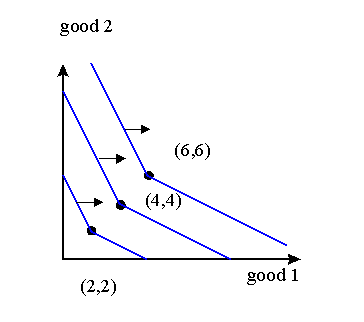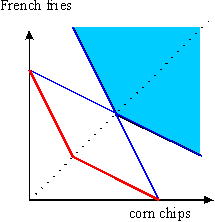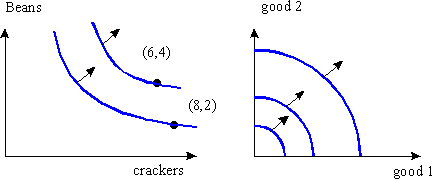Econ 302: Solutions for Practice Questions 3
Question 1:
In order to find indifference curves
we start from a particular consumption bundle, say (2,2).
We want to find exchanges
Dx2/Dx1 that lead to other consumption
bundles on the same indifference curve.
Note that the exchange ratio is Dx2/Dx1=-1/2 if x1>=x2, and Dx2/Dx1=-2 if x2>=x1. Thus, the indifference curves have a kink at x1=x2.

Question 2:
- Note that u1(x1,x2)=1 and u2(x1,x2)=4, because of additivity. Thus, since MRS(x)=-u1/u2, we get MRS=-1/4.
- u1(x1,x2) =2x1 and u2(x1,x2)=1. Thus, the MRS is given by MRS(x)=-2x1.
- u1(x1,x2) = 1 and u2(x1,x2) = (1/x22), because of additivity. Thus, MRS(x)=-1/(1/x22)=-x22
- u1(x1,x2) = (1/2)x1-1/2=1/(2x11/2), and u2(x1,x2) = (1/2)x2-1/2 = 1/(2x21/2) Thus, the MRS is given by MRS(x)=-x21/2/x11/2.
- At (8,2) it follows that 2x1+x2=18 and x1+2x2=12. Thus, his utility is 12, the smaller of the two numbers 18 and 12.
-
When graphing the indifference curve for which
u(x1,x2)=12, first graph the two lines
2x1+x2=12 and
x1+2x2=12. Clearly, any consumption bundle
which is to the right of both lines in you graph has a utility of at
least 12. The set of all such consumption bundles is the at least as good
set (blue in the graph). The lower boundary of the set is
the indifference curve. It is the collection of consumption bundles
which are on one of the two lines but to the right of the other one.
In order to get the indifference curve for the utility level 6, we
proceed as above (substituting the number 12 by the number 6).

- At (5,2) we get 2x1+x2=12 and x1+2x2=7. Thus, x1+2x2=7 describes the indifference curve at (5,2). This is a straight line with slope -1/2, i.e., the MRS= Dxf/Dxc=-1/2 where xf is the amount of fries and xc the amount of chips. If xf=1 then xc=-2. Therefore he would be willing to trade 2 units of corn chips for one unit of fries.
Question 4: The indifference curves are L shaped (perfect complements) as in Figure 3.4 or 5.6 in the textbook. The only difference is that the "kink" of each indifference curve occurs at consumption bundles (x1,x2) for which x1=3x2 (e.g., (3,1), (6,2), etc).
The utility of (5,5) is 5. The utility of (5.01,4) is 5.01. Thus, the consumer would trade.
The utility of (4.99,6) is 4.99. Thus, the consumer would not trade.
Question 5: A utility function is u(x1,x2) = min{x1,x2} or any monotonic transformation of it. E.g., u(x1,x2) = min{x1,x2}2 or u(x1,x2) =100 min{x1,x2}2+10, etc.,
Question 6:
- Yes
- No
- Yes
- Yes
- Yes
- No
- Yes
Question 7: Martha has a Cobb-Douglas utility function which is a monotonic transformation of u(x1,x2) = x1x2. The graph of the indifference curves are indicated below on the left (they should look approximately like that in Figure 4.3 in the textbook)

Bertha's preferences are exactly the same. They are just a monotonic transformation of Bertha's. Thus, you get the same picture. Moreover, both preferences are convex.
Question 8: The indifference curves are quarter circles centered at (0,0) as indicated in the graph above (on the right). The preferences are not convex.